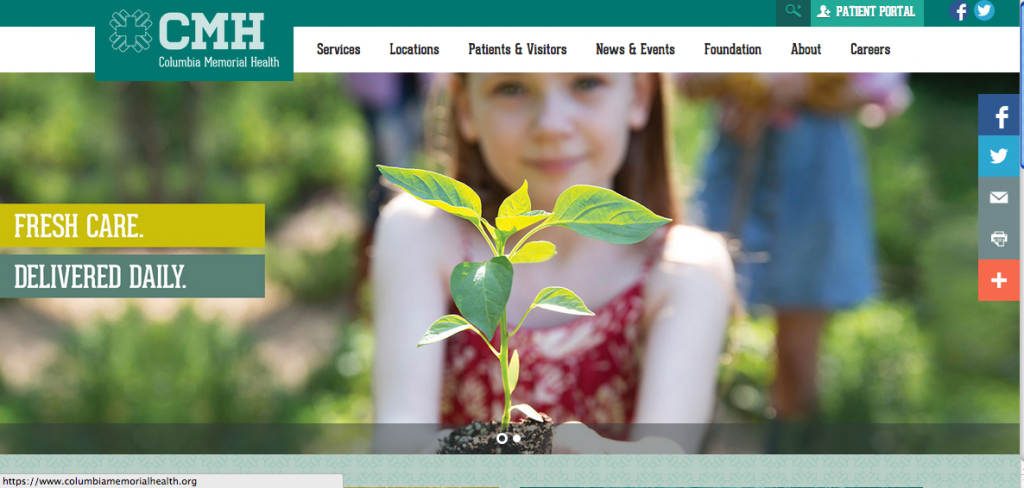Columbia Memorial Health Rebrands With a Focus on Wellness, Making Hay With “Locally Sourced” Theme

Rip Van Winkle Bridge, Sponsored by Columbia Memorial Health, Connects Columbia & Greene Counties
Columbia Memorial Health (CMH) in Hudson, New York is about two and a half hours from New York City and Boston, and a 45-minute drive from Albany. How does a small community hospital in upstate New York compete, when patients have easy access to their pick of world-class hospitals like Mt. Sinai and Mass General, and major academic medical centers like Albany Medical Center?
Focus on Consumers and Primary Care Sets CMH Apart
CMH chose to focus on primary care. “The entire healthcare system is moving toward second-curve payment models,” says Bill Van Slyke, Vice President, Marketing and External Affairs at CMH. “Whether you’re in a fee-for-service, capitated, or value-based payment system, primary care seems to be the best place to start for everyone.” CMH has 17 primary care offices throughout its service area, covering a population of 100,000 in Columbia County on the eastern side of the Hudson River, and Greene County to the west. “Only about 30 percent of our revenue is inpatient hospital care now,” says Van Slyke.
CMH worked with Smith & Jones, a Troy, New York healthcare marketing agency, to redefine its brand and identify strategic opportunities. “I was looking at healthcare marketing and advertising strategies and tactics, and it was so physician-oriented,” says Van Slyke. “Consumer marketing is all about establishing an emotional connection.” After vetting several firms, Van Slyke chose Smith & Jones. “When I met with Mark [Mark Shipley, CEO, Strategy Director] and a colleague of his at Smith & Jones, he was already there.”
A Unified Brand for a Diverse Community
The initial challenge was to identify brand attributes that would resonate with everyone in the diverse community. “They’re kind of a unique hospital because they have a fairly affluent community of second-home owners from the New York City metro area, and then they also have the rural poor that they provide services for,” says Shipley. Van Slyke says, “We thought, what do they all have in common? What do they all care about? It’s an incredibly gorgeous place to live. And that was it.” When Smith & Jones presented the new brand concept “Fresh Care, Delivered Daily,” Van Slyke says he hesitated for a full 30 seconds. “In my mind I was saying, my God, they did what we asked them. I hope we’re right.”
Focus on Health and Wellness
The next objective was to put the spotlight on primary care. “What we helped them understand was that they needed to build their brand around their primary care network,” says Shipley. Kate McElroy, Account Director at Smith & Jones, adds, “The primary care campaign has been really critical in redefining the organization as a source for health and wellness in the community.”
In addition to its robust primary care network, CMH has expertise in several subspecialty areas, including bone and joint and women’s health. “[Primary care] is the top of the funnel for us,” says Van Slyke. “We can manage care better, we can introduce population health techniques, and also, while we’re still in fee-for-service, we can be sure to capture as much of the subspecialty service as possible in our network.”
Primary Care Focus Improves Efficiency for Subspecialties
The focus on primary care improves the efficiency of the subspecialty areas. McElroy illustrates with an example of patients who go straight to an orthopedic surgeon when they have pain in their knees or back. “They show up and their BMI is off the charts, and they’re not ready for surgery,” says McElroy. “If they start with their primary care physician, the doctor can give them insight into what they could do to improve their candidacy for surgery.” Once patients address the underlying issues, they are better candidates for surgery, and in some cases may not need surgery at all. “You’re creating a population that’s healthier and needs less of that really specialized and expensive care,” says McElroy.
Integrated Campaign Uses Owned Media and Digital Ads
The campaign to introduce the new brand capitalized on owned media as well as paid digital advertising and TV. “We tend to look at owned media first,” says Shipley, naming the physical plant as well as digital assets such as the organization’s website, Facebook page, and Twitter feed. “When you have 17 primary care offices, there are a lot of patients going through there on a regular basis,” says Shipley. Each of the network’s 220 patient examination rooms features a large, colorful poster incorporating the imagery from the campaign.
Hospital employees are another significant touchpoint. “When you look at the main hospital, they have 1,400 employees who all have families and all live in the community,” says Shipley.
The centerpiece of the campaign was a new website designed around the “fresh care, delivered daily” brand elements. The site has a user-friendly navigation scheme with ubiquitous calls to action to find a primary care physician. Physician videos are prominently featured. There are 25 physician videos on the site.
Videos Forge Emotional Connection with Patients
The strategy for the videos was to shoot with the area’s natural surroundings as a backdrop, and showcase the physicians as members of the local community. “We shot at two outdoor landmarks on either side of the river, to speak to both communities on either side of the river,” says Van Slyke. Shipley says, “These are people who have chosen to live there. A lot of them have studied at the best teaching institutions in the country and then they made the decision to live in this rural community.”
CMH used some of the video content as source material for three 30-second TV spots. “We are fortunate we are in a very small cable market,” says Van Slyke. “Mid-Hudson Cablevision almost mirrors exactly our service area, so there’s almost no waste in the buy.” CMH posted the TV spots on Facebook and within 24 hours had 1,800 views. “For a covered population of 100,000 people, we were very pleased with that number,” Van Slyke says.
Digital Ads Drive Increase in Appointment Requests
The new website launched in December 2014, followed by an aggressive online advertising campaign beginning in the first two weeks of January, which includes re-targeting ads, digital display ads, and search ads. “We continue to make sizable investments in terms of a proportion of our marketing buy digitally,” says Van Slyke.
 CMH does not currently use a CRM system. Although it is too early to track downstream revenue related to the campaign, there has been a significant increase in requests for appointments. “It seems to be generating a fair number of online appointments,” says Van Slyke, “and I do believe it’s probably not unfair to extrapolate that into appointments that people are making by picking up the phone, based on the phone number information they find on the website as well.”
CMH does not currently use a CRM system. Although it is too early to track downstream revenue related to the campaign, there has been a significant increase in requests for appointments. “It seems to be generating a fair number of online appointments,” says Van Slyke, “and I do believe it’s probably not unfair to extrapolate that into appointments that people are making by picking up the phone, based on the phone number information they find on the website as well.”


